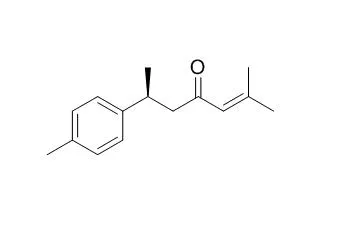| In vitro: |
| Sci Rep. 2016 Nov 2;6:34093. | | Turmeric powder and its derivatives from Curcuma longa rhizomes: Insecticidal effects on cabbage looper and the role of synergists.[Pubmed: 27804972 ] | Curcuma longa has well-known insecticidal and repellent effects on insect pests, but its impact on Trichoplusia ni is unknown.
METHODS AND RESULTS:
In this study, the compound ar-Turmerone, extracted and purified from C. longa rhizomes, was identified, and its insecticidal effects, along with turmeric powder, curcuminoid pigments and crude essential oil were evaluated against this important agricultural pest. The role of natural (sesamol and piperonal) and synthetic [piperonyl butoxide (PBO)] synergists under laboratory and greenhouse conditions were also evaluated. The concentration of ar-Turmerone in C. longa rhizomes harvested was 0.32% (dwt). Turmeric powder and its derivatives caused 10-20% mortality in third instar T. ni at a very low dose (10 μg/larva). Addition of PBO increased toxicity of turmeric powder and its derivatives (90-97% mortality) in most binary combinations (5 μg of turmeric powder or its derivatives +5 μg of PBO), but neither piperonal nor sesamol were active as synergists. The compound ar-Turmerone alone and the combination with PBO reduced larval weight on treated Brassica oleracea in the laboratory and in greenhouse experiments, compared with the negative control.
CONCLUSIONS:
The compound ar-Turmerone could be used as a low cost botanical insecticide for integrated management of cabbage looper in vegetable production. | | Medicines (Basel). 2015 Dec 21;2(4):340-349. | | Chemotaxonomic Characterization and in-Vitro Antimicrobial and Cytotoxic Activities of the Leaf Essential Oil of Curcuma longa Grown in Southern Nigeria.[Pubmed: 28930216 ] | Curcuma longa (turmeric) has been used in Chinese traditional medicine and Ayurvedic medicine for many years.
METHODS AND RESULTS:
The leaf essential oil of C. longa from southern Nigeria was obtained by hydrodistillation and analyzed by gas chromatography-mass spectrometry (GC-MS). The essential oil was screened for in vitro antibacterial, antifungal, and cytotoxic activities. The major components in C. longa leaf oil were ar-Turmerone (63.4%), α-turmerone (13.7%), and β-turmerone (12.6%). A cluster analysis has revealed this to be a new essential oil chemotype of C. longa.
The leaf oil showed notable antibacterial activity to Bacillus cereus and Staphylococcus aureus, antifungal activity to Aspergillus niger, and cytotoxic activity to Hs 578T (breast tumor) and PC-3 (prostate tumor) cells.
CONCLUSIONS:
The ar-Turmerone-rich leaf essential oil of C. longa from Nigeria has shown potent biological activity and therapeutic promise. | | J Med Entomol. 2015 Sep;52(5):979-86. | | Larvicidal and Biting Deterrent Activity of Essential Oils of Curcuma longa, Ar-turmerone, and Curcuminoids Against Aedes aegypti and Anopheles quadrimaculatus (Culicidae: Diptera).[Pubmed: 26336212] | Essential oils and extract of Curcuma longa, ar-Turmerone, and curcuminoids were evaluated for their larvicidal and deterrent activity against mosquitoes.
METHODS AND RESULTS:
ar-Turmerone and curcuminoids constituted 36.9, 24.9 and 50.6% of rhizome oil, leaf oil, and rhizome extract, respectively. ar-Turmerone was the major compound of the rhizome oil (36.9%) and leaf oil (24.9%). The ethanolic extract had 15.4% ar-Turmerone with 6.6% bisdesmethoxycurcumin, 6.1% desmethoxycurcumin, and 22.6% curcumin. In in vitro studies, essential oils of the leaf (biting deterrence index [BDI] = 0.98), rhizome (BDI = 0.98), and rhizome ethanolic extract (BDI = 0.96) at 10 μg/cm(2) showed biting deterrent activity similar to DEET at 25 nmol/cm(2) against Aedes aegypti L. Among the pure compounds, ar-Turmerone (BDI = 1.15) showed the biting deterrent activity higher than DEET at 25 nmol/cm(2) whereas the activity of other compounds was lower than DEET. In Anopheles quadrimaculatus Say, only ar-Turmerone showed deterrent activity similar to DEET. In dose-response bioassay, ar-Turmerone showed significantly higher biting deterrence than DEET at all the dosages. ar-Turmerone, at 15 nmol/cm(2), showed activity similar to DEET at 25 nmol/cm(2) and activity at 5 nmol/cm(2) was similar to DEET at 20 and 15 nmol/cm(2). Leaf essential oil with LC(50) values of 1.8 and 8.9 ppm against larvae of An. quadrimaculatus and Ae. aegypti, respectively, showed highest toxicity followed by rhizome oil and ethanolic extract.
CONCLUSIONS:
Among the pure compounds, ar-Turmerone with LC(50) values of 2.8 and 2.5 ppm against larvae of An. quadrimaculatus and Ae. aegypti, respectively, was most toxic followed by bisdesmethoxycurcumin, curcumin, and desmethoxycurcumin. |
|






 Cell. 2018 Jan 11;172(1-2):249-261.e12. doi: 10.1016/j.cell.2017.12.019.IF=36.216(2019)
Cell. 2018 Jan 11;172(1-2):249-261.e12. doi: 10.1016/j.cell.2017.12.019.IF=36.216(2019) Cell Metab. 2020 Mar 3;31(3):534-548.e5. doi: 10.1016/j.cmet.2020.01.002.IF=22.415(2019)
Cell Metab. 2020 Mar 3;31(3):534-548.e5. doi: 10.1016/j.cmet.2020.01.002.IF=22.415(2019) Mol Cell. 2017 Nov 16;68(4):673-685.e6. doi: 10.1016/j.molcel.2017.10.022.IF=14.548(2019)
Mol Cell. 2017 Nov 16;68(4):673-685.e6. doi: 10.1016/j.molcel.2017.10.022.IF=14.548(2019)